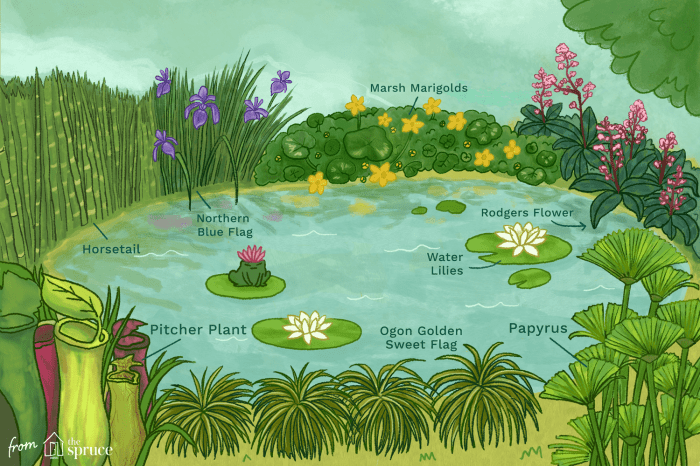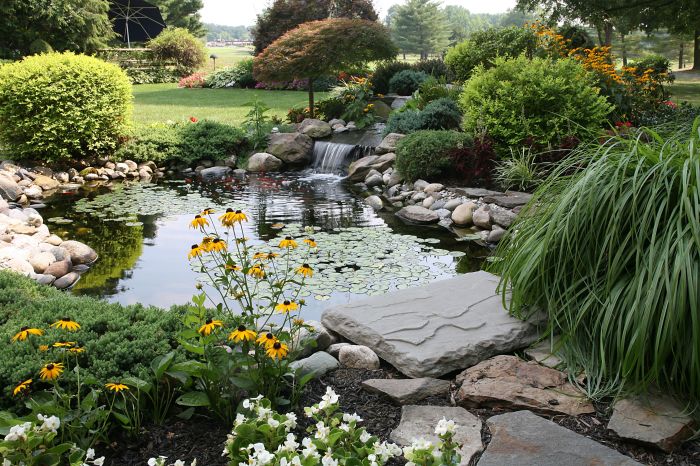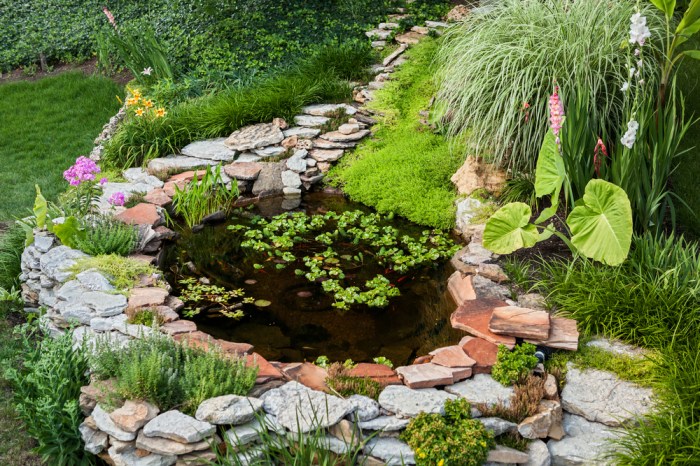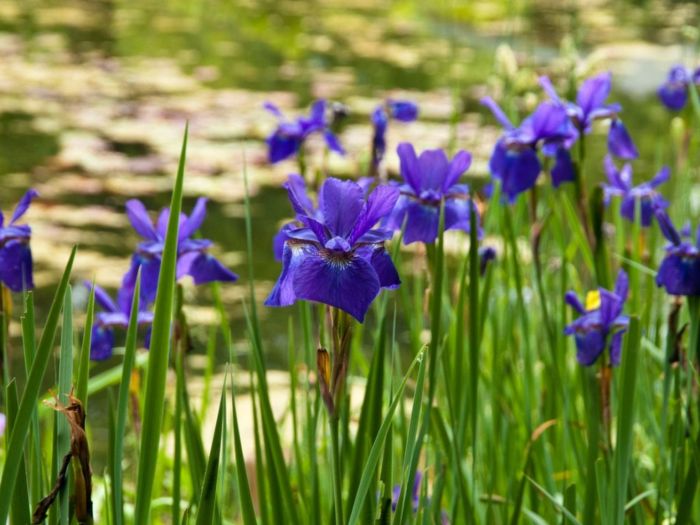Discover the best plants for around pond that transform your water feature into a thriving ecosystem and visual masterpiece. From moisture-loving species to aesthetic wonders, these plants offer a symphony of benefits, enhancing wildlife habitats, filtering water, and creating a tranquil oasis.
Whether you have a sprawling pond or a cozy water garden, our comprehensive guide provides expert insights into selecting, planting, and caring for the perfect pond plants. Embrace the beauty of nature and create a harmonious haven for both you and the wildlife that surrounds you.
Popular Plants for Pond Surroundings

When selecting plants for around a pond, consider factors such as moisture tolerance and root systems. Choose plants that thrive in moist environments and have non-invasive root systems to avoid damage to the pond liner.
Some popular plant species for pond surroundings include:
Moisture-Loving Plants
- Watercress:Fast-growing, semi-aquatic plant that can tolerate partial shade and prefers moist soil.
- Marsh Marigold:Showy plant with bright yellow flowers that prefers boggy areas.
- Cardinal Flower:Tall, striking plant with bright red flowers that attracts hummingbirds.
Plants with Non-Invasive Roots
- Japanese Iris:Ornamental plant with showy flowers that prefers moist soil but has shallow roots.
- Hosta:Shade-loving plant with large, attractive leaves that has shallow, fibrous roots.
- Astilbe:Showy plant with feathery flower spikes that prefers moist soil but has non-invasive roots.
Benefits of Plants Around Ponds

Incorporating plants around ponds offers a plethora of ecological and aesthetic advantages that enhance the overall ecosystem and visual appeal.
Ecologically, plants provide a vital habitat for diverse wildlife, including insects, amphibians, and birds. The lush vegetation creates shelter and nesting sites, fostering a thriving ecosystem.
Water Filtration
Plants act as natural water filters, absorbing excess nutrients and pollutants from the pond water. This process helps maintain water quality, reducing the growth of algae and promoting a healthy aquatic environment.
Erosion Prevention
The root systems of plants stabilize the soil around ponds, preventing erosion and maintaining the integrity of the pond’s edges. This is particularly important in areas with sloping terrain or heavy rainfall.
Aesthetic Value
Aesthetically, plants enhance the visual appeal of ponds, creating a serene and picturesque atmosphere. The vibrant colors, textures, and forms of plants add depth and interest to the pond environment.
Planting Considerations: Best Plants For Around Pond

Selecting the appropriate plants for your pond’s size and shape is crucial for aesthetic appeal and ecological balance. Consider the following guidelines:
For small ponds, choose compact plants with shallow root systems, such as watercress or creeping Jenny. Larger ponds can accommodate taller plants like irises or cattails. Ponds with irregular shapes may benefit from a mix of plants to create visual interest and provide varying depths for wildlife.
Surrounding a pond with lush greenery can enhance its beauty and provide habitat for wildlife. When selecting plants for this area, consider species that thrive in moist environments. Some excellent choices include irises, ferns, and water lilies. For containers near the pond or on a patio, explore best plants to pot that tolerate wet conditions, such as hostas, begonias, and coleus.
These versatile plants can add color and texture to your pondside oasis.
Spacing and Depth
Proper spacing ensures optimal growth and prevents overcrowding. Space plants according to their size and root spread. Submerged plants can be placed deeper, while emergent plants should be planted at varying depths to create a tiered effect.
When considering the best plants for around a pond, it’s essential to choose species that can withstand the moisture and thrive in such an environment. While researching the best plants for crested geckos, here are some excellent options to consider, like the Pothos plant, which is known for its hardiness and ability to tolerate wet conditions.
Returning to the topic of plants around ponds, remember to select species that complement the ecosystem and provide shelter for wildlife.
Soil Conditions
Most aquatic plants prefer moist, organic soil rich in nutrients. Amend the soil with compost or peat moss to improve drainage and fertility. For boggy areas, consider plants that thrive in saturated conditions, such as rushes or sedges.
Planting Techniques
Proper planting techniques ensure plant health and longevity. Dig holes deep enough to accommodate the plant’s roots. Gently spread the roots and backfill with soil, tamping down gently to remove air pockets. Water the plants thoroughly after planting.
When selecting plants for around a pond, consider those that thrive in moist environments. Water lilies, cattails, and irises are all excellent choices. For a touch of elegance, consider adding hanging baskets filled with trailing plants such as best plants in hanging baskets . These plants will cascade over the edge of the basket, creating a beautiful and inviting atmosphere around your pond.
Plant Maintenance and Care
Maintaining the health and beauty of plants around ponds requires ongoing care. Regular watering, fertilizing, and pruning are essential, as well as managing pests and diseases that may affect pond plants.
Enhancing the aesthetic appeal of a pond area requires careful plant selection. Water lilies, with their vibrant blooms and floating pads, are a classic choice. For a touch of vertical interest, consider adding hanging plants indoors such as ferns , which thrive in humid environments and can be suspended above the pond’s surface.
These plants not only add visual depth but also help filter the water, creating a healthy ecosystem for aquatic life.
Watering
The frequency of watering depends on factors such as the type of plants, soil conditions, and climate. Plants with shallow root systems or those in sandy soil may require more frequent watering than those with deep root systems or in heavy soil.
During hot, dry weather, all plants may need more frequent watering.
Fertilizing, Best plants for around pond
Plants around ponds typically benefit from regular fertilization. A balanced fertilizer can be applied monthly during the growing season. Avoid over-fertilizing, as this can lead to algal blooms in the pond.
Pruning
Pruning helps to control the size and shape of plants, remove dead or diseased foliage, and encourage new growth. Prune plants regularly to maintain their desired size and shape. Remove any dead or diseased leaves or stems as soon as possible.
Pest and Disease Management
Pests and diseases can affect pond plants. Aphids, spider mites, and mealybugs are common pests. Fungal diseases, such as powdery mildew and rust, can also affect pond plants.
Integrated pest management (IPM) techniques can be used to manage pests and diseases. IPM involves using a combination of methods, such as biological control, cultural practices, and chemical controls, to minimize the impact of pests and diseases while protecting the environment.
Seasonal Maintenance
Seasonal maintenance is important to keep plants around ponds thriving throughout the year.
- In spring, prune plants to remove dead or diseased foliage and encourage new growth.
- In summer, water plants regularly and fertilize monthly.
- In fall, remove dead or diseased foliage and cut back plants that have finished blooming.
- In winter, protect plants from cold temperatures by mulching around them or covering them with a blanket.
Creative Plant Combinations
To create visually stunning plant combinations around ponds, consider the height, texture, and color of the plants. For instance, tall plants can provide a dramatic backdrop, while shorter plants can add interest in the foreground. Plants with contrasting textures, such as ferns and grasses, can create a dynamic display.
Incorporating a variety of colors can bring vibrancy and visual appeal to the pond surroundings.
Complementary Combinations
- Japanese Iris and Hostas:The bold blooms of Japanese irises complement the lush foliage of hostas, creating a striking contrast in height and texture.
- Water Lilies and Pickerelweed:The floating leaves of water lilies provide a tranquil surface, while the upright stems of pickerelweed add vertical interest and attract pollinators.
- Dwarf Mondo Grass and Creeping Jenny:The low-growing mondo grass forms a dense carpet, while the trailing stems of creeping Jenny cascade over the pond’s edge, creating a lush and inviting border.
Epilogue

Transform your pond into a sanctuary of beauty and ecological wonder with our curated selection of the best plants for around pond. Their adaptability, aesthetic appeal, and ecological benefits make them essential elements in any pond ecosystem. By following our planting and care tips, you can create a thriving and visually stunning oasis that will bring joy and serenity for years to come.
Common Queries
What are the best plants for around a small pond?
For small ponds, consider dwarf water lilies, marginal plants like creeping Jenny, and floating plants like water hyacinth or duckweed.
How deep should I plant pond plants?
Planting depth varies depending on the plant species. Follow the specific guidelines for each plant, ensuring the crown is at or slightly above the water surface for marginal plants and submerged below the surface for aquatic plants.
How often should I fertilize pond plants?
Fertilize aquatic plants monthly during the growing season with a slow-release fertilizer specifically designed for water plants.